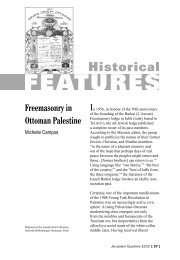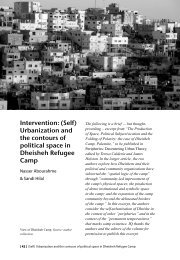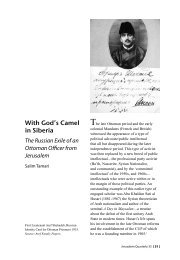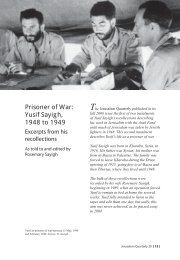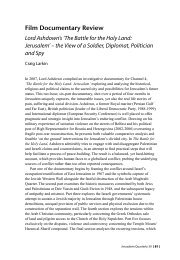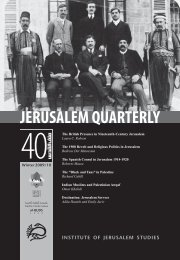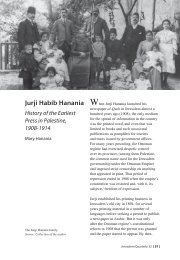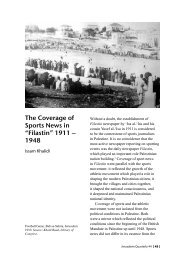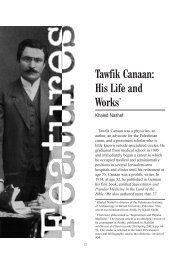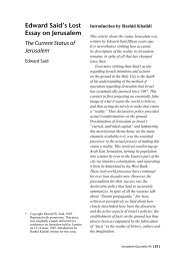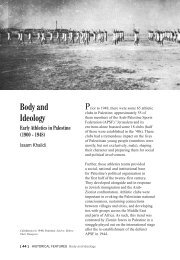In Search of Jerusalem Airport [pdf] - Jerusalem Quarterly
In Search of Jerusalem Airport [pdf] - Jerusalem Quarterly
In Search of Jerusalem Airport [pdf] - Jerusalem Quarterly
You also want an ePaper? Increase the reach of your titles
YUMPU automatically turns print PDFs into web optimized ePapers that Google loves.
<strong>In</strong> <strong>Search</strong> <strong>of</strong><strong>Jerusalem</strong> <strong>Airport</strong>Nahed AwwadEgyptian and foreign actors and actressesin the <strong>Jerusalem</strong> <strong>Airport</strong>. Photo Source:Collection <strong>of</strong> Rene Farhan Marouf, 1961.As most Palestinians, I know this placeby the name “Qalandia <strong>Airport</strong>”, namedafter the neighbouring village and refugeecamp. I’m from a generation that was bornafter the Israeli occupation <strong>of</strong> the West Bankand Gaza Strip in 1967 and what I knowabout the place was that small domesticIsraeli planes landed there in the 90’s whichI once watched on my way to work. LaterI witnessed the growth <strong>of</strong> the Qalandiacheckpoint to the east end <strong>of</strong> the runway,which is now considered one <strong>of</strong> the biggestcheckpoint in the West Bank that blocks the<strong>Jerusalem</strong>-Ramallah road, turning it into adead end street. The airport lies along theroad that links <strong>Jerusalem</strong> to Ramallah. Ithas been occupied by the Israeli army since1967, at a 5km distance from Ramallah and10km distance from <strong>Jerusalem</strong>.<strong>Jerusalem</strong> <strong>Quarterly</strong> 35 [ 51 ]
Although the <strong>Jerusalem</strong> <strong>Airport</strong> is five minutes away from Ramallah, the only way outfor us Palestinians today in the West Bank to the world is the Queen Alia <strong>Airport</strong> inAmman. Palestinians with West Bank identity cards are forbidden to use Ben Gurion<strong>Airport</strong> in Tel Aviv and Gaza’s airport that was destroyed by the Israeli governmentin 2002. The Palestinian Authority has had no permission from the Israelis to rebuildthe airport until today; even so I would need permission from the Israeli Authorities toenter Gaza in order to travel from there. It is hard to believe that the gate to the worldwas only five minutes from home.It was an eye opening experience for me listening to Abu Jamil retelling me hispersonal memories <strong>of</strong> the airport, a Ramallah book keeper who used to travel morethan once a week to Cairo and Beirut to acquire books for his shop, that was the firsttime I heard accounts <strong>of</strong> the ‘<strong>Jerusalem</strong> <strong>Airport</strong>’. Later I heard another story from atraveller that returned from the U.S. after completing her studies in 1963.It was however a different experience to lay my eyes on photos <strong>of</strong> the <strong>Airport</strong> for thevery first time. That was in the summer <strong>of</strong> 2005. I sat on the balcony <strong>of</strong> Rene FarhanMarouf’s house in Al Bireh. Rene is the wife <strong>of</strong> Farhan Marouf, a former employee <strong>of</strong>Arab Airways who had worked at the <strong>Jerusalem</strong> <strong>Airport</strong> for ten years.Group <strong>of</strong> travellers arriving to the <strong>Jerusalem</strong> <strong>Airport</strong>. Photo Source: Collection <strong>of</strong> Dr. Mohammed alQutub, 1963.[ 52 ] <strong>In</strong> <strong>Search</strong> <strong>of</strong> <strong>Jerusalem</strong> <strong>Airport</strong>
A group <strong>of</strong> tourists and pilgrims in front <strong>of</strong> the Departure Hall at the <strong>Jerusalem</strong> <strong>Airport</strong>. Photo Source:Collection <strong>of</strong> Youssef Hajjar, 1961.Marouf shared her husband’s photo collection <strong>of</strong> the <strong>Jerusalem</strong> <strong>Airport</strong> with me. Itwas a fascinating experience, for it was as if I was watching one <strong>of</strong> those classicalEgyptian movies starring women in wide fluffy dresses, wearing huge hats andoversized glasses. I was drawn to the outgoing atmosphere expressing freedom notonly in movement but also in the social values. This is how I fell in love with the<strong>Airport</strong> <strong>of</strong> <strong>Jerusalem</strong> and my passion for knowing the history <strong>of</strong> the place.I kept thinking about the photos, they inspired me to find out more about the timeand the place. Armed with a few photos and the names <strong>of</strong> some former co-workersfrom my initial contacts I started my journey <strong>of</strong> researching the history <strong>of</strong> the<strong>Jerusalem</strong> <strong>Airport</strong>. It was not easy. Although the airport once was a major traffic hub<strong>of</strong> our region and a Palestinian center, information about it was scarse, especiallyphotographic information as in many Palestinian archives have been destroyed orstolen. It was therefore clear to me that my search needed to focus on individualsand that I had to start from scratch. On my way, I met many wonderful people, airhostesses, traffic <strong>of</strong>ficers, pilots and others that were willing to share their stories,photos, and documents with me. I was happy to see the glow in their eyes when theymentioned the glorious days <strong>of</strong> the airport.<strong>Jerusalem</strong> <strong>Quarterly</strong> 35 [ 53 ]
Dignitaries in front <strong>of</strong> the main building <strong>of</strong> the <strong>Jerusalem</strong> <strong>Airport</strong>, in the middle Ruhi al Khatib, mayor <strong>of</strong><strong>Jerusalem</strong>, and to his left, Anwar Nusseibeh Jordanian Defense Minister. Photo source: Collection <strong>of</strong> theTamari Family, 1961.Family <strong>of</strong> Farhan Marouf in front <strong>of</strong> the <strong>Jerusalem</strong> <strong>Airport</strong> building. Photo Source: Collection <strong>of</strong> ReneFarhan Marouf, 1959.[ 54 ] <strong>In</strong> <strong>Search</strong> <strong>of</strong> <strong>Jerusalem</strong> <strong>Airport</strong>
The airport was established by the British Mandate in 1920’s. It was a small militarybase known by the British as ‘Kolundia Airfield’. <strong>In</strong> 1948, the British Mandate endedand the West Bank was put under the supervision <strong>of</strong> Jordan. <strong>In</strong> the early 1950’s theJordanians turned the airfield into a civil airport, erected the still existing airportbuilding and named it the <strong>Jerusalem</strong> <strong>Airport</strong>.The <strong>Airport</strong> traffic control building did not change much since the 50’s, the shape <strong>of</strong>it looked like an airplane or a ship. There was a left wing that was one long flat floor,the round part in the middle with the tower on top, and the right wing. Going throughthe main entrance into the round shaped hall, you’d find a souvenir shop and a moneyexchanger managed by Theresa Fanous. <strong>In</strong> the middle there was a spiral staircaseleading up to the terrace and the c<strong>of</strong>fee shop that was run by the Al Alami family andabove was the control tower. <strong>In</strong> the left wing <strong>of</strong> the building there were counters for themain airlines: Air Liban and Middle East Airline (in 1964 Air Liban was merged withMEA), Misr Air (Egypt Air), Trans Arabia Airline (the Kuwaiti Airline, in the 1950’sthere was a big wave <strong>of</strong> Palestinians traveling to work in the Gulf), Air Jordan <strong>of</strong> theHoly Land (now Royal Jordanian). There was also the royal room mainly used by KingHussein on his frequent visits to the airport and for welcoming important guests. <strong>In</strong> theright wing there were the customs <strong>of</strong>fices, the transit lounge and departure area includingpassport control, the tourist police, the health and fire department, and a post <strong>of</strong>fice.Today on the southern side <strong>of</strong> the runway (the <strong>Jerusalem</strong> side), there is a depot formini-buses displaying their route ‘<strong>Jerusalem</strong> <strong>Airport</strong> – Kufr Aqab’. The drivers arefrom Al Ram (the neighbouring city) or from <strong>Jerusalem</strong>. They are 25-45 years old andhave witnessed the place throughout the Israeli occupation. The <strong>Airport</strong>’s name alwayscrowns their buses, but they don’t know much about it.One driver: “The airport? It’s like a land mark. It’s true we can’t access it,but we are nearby, and it’s like a meeting point at the entrance <strong>of</strong> the cityor like a well-known store.”A few hundred meters from the van station, we arrive at a neighbourhood called the‘airport neighbourhood’: an enclave that is home to about 500 people, isolated from<strong>Jerusalem</strong> and Ramallah by Israeli checkpoints, walls, fences, and colonies. There Imet Norma Haweet who has always lived there. The house was built by her father in1947 and is still intact. The furniture in the salon reminded me <strong>of</strong> the atmosphere <strong>of</strong>that era: the seats had wooden handles partially covered with velvet, and an old recordplayer that had the music <strong>of</strong> Arab and Western singers. Somehow, she is a key to thetime, and remains a witness to the site’s history.Looking around from the ro<strong>of</strong> <strong>of</strong> her house one sees the airport’s control tower onthe left, a camouflage net covers part <strong>of</strong> the building. Opposite to us is the runway,and to the right the old road connecting <strong>Jerusalem</strong> and Ramallah that used to cross<strong>Jerusalem</strong> <strong>Quarterly</strong> 35 [ 55 ]
Hawitt family in reception for one <strong>of</strong> their sons studying at the American University <strong>of</strong> Beirut. PhotoSource: Collection Norma Hawitt.Tania, Vera, Vladimir, with their mother Margo Dabbas traveling to Beirut in front <strong>of</strong> an Arab Airwaysairplane. Photo Source: Collection Tamari Family, 1950[ 56 ] <strong>In</strong> <strong>Search</strong> <strong>of</strong> <strong>Jerusalem</strong> <strong>Airport</strong>
the runway. A few meters in front <strong>of</strong> thebarrier blocking the entrance to the sitestands the small ‘airport mosque’. Itwas built by Kuwaitis who lived in theneighbourhood until 1967. They usedto spend their summer vacations hereand visited their children who studiedin <strong>Jerusalem</strong> at the Mutran and SchmidtSchools for they sought a better educationfor their children other than what wasavailable in other Arab cities. At the time,these schools were considered some <strong>of</strong>the best schools in the Middle East withstudents from other Arab countries.Norma recalls:“My brother studied in Beirutin the 1950s. He used to comehome to visit and called toinform us about his arrivaltime. When we would hearthe plane’s engines, we wouldrun up to the ro<strong>of</strong> to watch theplane land, and then we’d runtoward the airport to pick himup. Before he would leave theplane, we would be on thebalcony waiving to him…”From the <strong>Airport</strong> neighbourhood I wasled to Amman to meet Hania Yasmina,a former air and ground hostess whoworked in the <strong>Jerusalem</strong> <strong>Airport</strong> for threeyears. She once lived in a house only afew meters to the north <strong>of</strong> the runwaybefore she got married and moved toAden, Yemen with her husband Nabil.They were outside <strong>of</strong> Palestine when thewar <strong>of</strong> 1967 broke out and they haven’tbeen able to return since. They live inAmman until today. On route to Hania’shouse we can’t see the <strong>Airport</strong> from itsDocuments: Correspondence between IbrahimHawitt and the British Mandate Administration <strong>of</strong>the Qalandia <strong>Airport</strong> concerning a requested permitfor building a house on lands next to the airfield.Source: Collection Norma Hawitt, 1945.<strong>Jerusalem</strong> <strong>Quarterly</strong> 35 [ 57 ]
Fareed al Atrash arriving to <strong>Jerusalem</strong> <strong>Airport</strong>, 1961.The American actress Katherine Hepburn in the <strong>Jerusalem</strong> <strong>Airport</strong>. Photo Source: Collection <strong>of</strong> YoussefHajjar, beginning 1960s.[ 58 ] <strong>In</strong> <strong>Search</strong> <strong>of</strong> <strong>Jerusalem</strong> <strong>Airport</strong>
northern side, the Ramallah side. <strong>In</strong> order to catch a glance, you need to walk about200m on a side alley, barely wide enough for a car. Turning to the left, after passing anumber <strong>of</strong> houses – one reaches Hania’s house – the Israeli wall obscures the sight <strong>of</strong>the runway. But the control tower is visible. When I face the airport, I can see the mainbuilding behind the yellow barrier. Here only the shadows <strong>of</strong> clouds and birds are ableto land amidst the bushes, abandoned vehicles, stray dogs and military jeeps that passfrom time to time. <strong>In</strong> her looks and way, Hania Yasmina still has the style <strong>of</strong> an airhostess. She recalls these times with a laugh.Hania: “I went from our home to the airport walking, I simply crossed therunway. Two minutes and I was at work. We had lots <strong>of</strong> fun; we worked from6am to 6pm and never felt tired. We were like a small family. Later I workedin other places, too, but it was never like the <strong>Jerusalem</strong> <strong>Airport</strong>.”The essence <strong>of</strong> it all: For Palestinians, the <strong>Jerusalem</strong> <strong>Airport</strong> was their gate to theworld and it was the entrance to the Holy Land for tourists, pilgrims, and the whole<strong>of</strong> the Arab world. Lots <strong>of</strong> famous people actors, religious figures, and politicians alllanded in the <strong>Jerusalem</strong> <strong>Airport</strong>.Hania: “Omar al Sharif came to the airport. He spent his vacation in<strong>Jerusalem</strong> and stayed at the American Colony Hotel during the shooting <strong>of</strong>‘Lawrence <strong>of</strong> Arabia’ in Jordan. He would approach us to chat and I recallhim commenting on our hairdo in his lovely Egyptian accent. He thoughtthat women shouldn’t pin their hair up but leave it loose, because a woman’sbeauty was her hair. Farid al Atrash also came once after he sang for theKing in Jordan. He was quite a gentleman.”<strong>In</strong> my search for pilots I was told that I would be able find Captain Amin al Husseini inAmman sitting in the Jordan Hotel Café/Bar every day around noon. And indeed, thereI found him sitting with a friend drinking a beer. <strong>In</strong> 1956, Captain al Husseini trainedto become a pilot in Texas, U.S.A. He dreamed <strong>of</strong> becoming a military pilot, but hisrespective application was rejected most likely because he was a Palestinian so he toldme. So, he trained to be a civil pilot. He worked with Air Jordan serving on the routefrom Amman to <strong>Jerusalem</strong> and from there to Beirut, Cairo, Kuwait, and Jeddah. <strong>In</strong> 1965he became the chief pilot <strong>of</strong> Air Jordan and later he was King Hussein’s private pilot fortwenty years. Between 1957 and 1967, Captain al Husseini flew every day from Ammanto <strong>Jerusalem</strong>.Captain al Husseini: “The runway was 6000 feet long. We navigated onsight. The <strong>Airport</strong> was open during the day only. When we wanted to land,someone from the airport tower – I only recall his family name, Totah –started a honk…hoooooo, to stop the traffic for us to land. It took us 11minutes from take <strong>of</strong>f in Amman to touch down. Wow, it was very nice; I<strong>Jerusalem</strong> <strong>Quarterly</strong> 35 [ 59 ]
Pilots and air hostesses <strong>of</strong> Air Jordan in front <strong>of</strong> <strong>Jerusalem</strong> <strong>Airport</strong>, among them Captain Amin al Husseini.Photo Source: Collection Martha Melhes.[ 60 ] <strong>In</strong> <strong>Search</strong> <strong>of</strong> <strong>Jerusalem</strong> <strong>Airport</strong>
emember in front <strong>of</strong> the airport building there were nice flowers and somestairs. When I landed the workers brought me fresh Ka’k (sesame bread)from Damascus Gate. We would sit on the stairs and eat together meanwhilethe passengers were boarding. Then we took <strong>of</strong>f for Beirut.”Husseini adds: “<strong>In</strong> 1961 I was the private pilot for Peter O’Toole and OmarAl Sharif for one month when they were filming Lawrence <strong>of</strong> Arabia. Theyrented the airplane from Air Jordan, it was a Dakota DC3. I remember thatPeter O’Toole was drunk most <strong>of</strong> the time.”Captain al Husseini was the first pilot to land with a jet plane – the “Caravel” – in the<strong>Jerusalem</strong> <strong>Airport</strong> in 1964.Legally, according to the <strong>In</strong>ternational Civil Aviation Organization (ICAO) AssemblyResolutions, the airport is still registered as the <strong>Jerusalem</strong> <strong>Airport</strong> located in theoccupied Arab territories and registered under the jurisdiction <strong>of</strong> Jordan in the ICAOMiddle East Air Navigation Plan. Consequently, Israel was not allowed to use the<strong>Jerusalem</strong> <strong>Airport</strong> as an international airport. After repairing its war-related damages,the <strong>Jerusalem</strong> <strong>Airport</strong> was re-opened in 1969 and was only used for domestic flights.Israel once tried to break the ICAO resolution by directing an airplane in bound fromEurope to the <strong>Jerusalem</strong> <strong>Airport</strong>. But the attempt didn’t succeed due to the resolutionsthat were produced by the Arab governments which stated that any airlines landing atthe <strong>Jerusalem</strong> <strong>Airport</strong> would not be allowed to enter their countries.The future <strong>of</strong> the <strong>Airport</strong> remains unknown. Since the 1990’s some articles werepublished in various newspapers that proposed future scenarios for the airport. <strong>In</strong>1992, for example, an article was published in the Al Quds newspaper stating thatan Israeli businessman was willing to turn the airport into a pilot school. That sameyear another article elaborated on German support for turning the airport into anIsraeli/Palestinian airport in which the runway would be divided into two lanes, onefor Israeli, the other for Palestinian planes. Much later, in May 2007, another articleappeared in the same newspaper showing a map indicating the location <strong>of</strong> a newIsraeli colony that was being planned to be built on the airport’s land.As <strong>Jerusalem</strong> is one <strong>of</strong> the delayed issues in the negotiations between the IsraeliGovernment and the Palestinian Authority, the future <strong>of</strong> the <strong>Jerusalem</strong> <strong>Airport</strong> remainspending. Besides the army jeeps and the dogs that patrol the runway from time totime, there will be no traffic in the <strong>Jerusalem</strong> <strong>Airport</strong> until further notice. Today, thesite is not only occupied, it barely even exists in the memories <strong>of</strong> my generation, and itremains hidden in the minds <strong>of</strong> the people who knew it as an aviation hub. During myresearch I was only able to find a few lines and paragraphs about the airport mainlyunder the name <strong>of</strong> Qalandia, Kalandia, or Atarot, as the Israelis call it. The only photosI was able to find from public sources were those taken after 1967.<strong>Jerusalem</strong> <strong>Quarterly</strong> 35 [ 61 ]
Crew <strong>of</strong> the Arab Airways. Photo Source: Collection <strong>of</strong> Rene Farhan Marouf, 1960.Employee identification card issued by Hashemite Kingdom <strong>of</strong> Jordan, Civil Aviation Ministry, <strong>Jerusalem</strong><strong>Airport</strong>, for employee Raji al Kaileh. Source: Collection Raji Kaileh, 1955.[ 62 ] <strong>In</strong> <strong>Search</strong> <strong>of</strong> <strong>Jerusalem</strong> <strong>Airport</strong>
My main sources were the people whoworked in the <strong>Airport</strong> or travelled fromit, those who kept photos and theirmemories. <strong>In</strong> my search for film footageI went to Jordan TV archives. I was ableto view the edited footage from the timesshowing King Hussein in the West Bankbut not the <strong>Airport</strong>. I have been told thatthe original negatives were burned due tostorage problems!I learned a lot through this excitingjourney. I discovered a part <strong>of</strong> my historyas a Palestinian that I knew nothingabout. I got a small taste <strong>of</strong> freedom andI was able to see the doorway that wasonce opened to the world. It is importantnot to remain stuck in a reality that hasbeen forced upon us, but rather it isimportant to provoke it which was theaim <strong>of</strong> my research. I would like to thankall those who shared their stories andphoto collections with me: Rene FarhanMarouf, Norma Hawitt, Hania Yasmina,Captain Amin al Husseini, Martha MelhesMohammed Sami Bitar, Yousef Hajjar,the Keili family and the Tamari family.<strong>In</strong>itially, this research was undertakento make a documentary film about the<strong>Jerusalem</strong> <strong>Airport</strong>. It was finalized inApril 2008 with the title “5 Minutes fromHome”, written and directed by NahedAwwad. Later, in the same year, photosand documents were on display in anexhibition <strong>of</strong> the same title: “5 Minutesfrom Home.”A travel ticket for Yousef Hajjar traveling from<strong>Jerusalem</strong>, Beirut and heading towards Dahran inSaudi Arabia dated 15/1/1967, 5 months before thewar <strong>of</strong> 1967.Return ticket to <strong>Jerusalem</strong> for Yousef Hajjar fromDahran dated 1971. Yousef Hajjar was incapable <strong>of</strong>flying directly back to <strong>Jerusalem</strong> <strong>Airport</strong> because<strong>of</strong> the 1967 war. His last destination on that routewas Amman. He needed to apply for “familyreunification” with the Israeli occupation authoritiesto re-enter <strong>Jerusalem</strong>.Nahed Awwad has been working in television and films since 1997. She finished adiploma in TV communication and video editing at Conway School in Canada.<strong>In</strong> 2003/2004 she studied documentary production at the European Film College inDenmark. <strong>In</strong> 2002 she made her first film titled “Lions”, followed by “Going For aRide?”, “25KM”, “The Fourth Room” (2005) “Not just any sea” (2006). <strong>In</strong> April,2008 she finished a long documentary titled “5 Minutes From Home”.<strong>Jerusalem</strong> <strong>Quarterly</strong> 35 [ 63 ]


![In Search of Jerusalem Airport [pdf] - Jerusalem Quarterly](https://img.yumpu.com/49007736/1/500x640/in-search-of-jerusalem-airport-pdf-jerusalem-quarterly.jpg)
